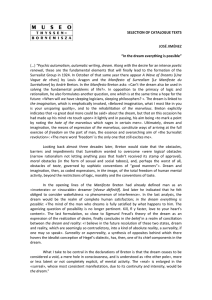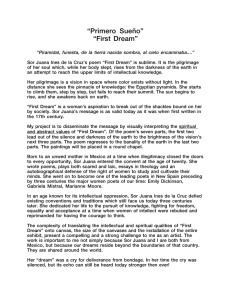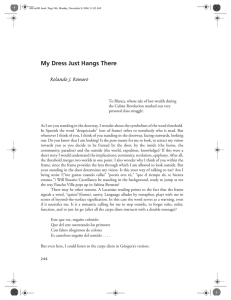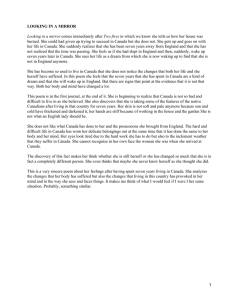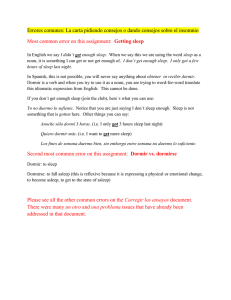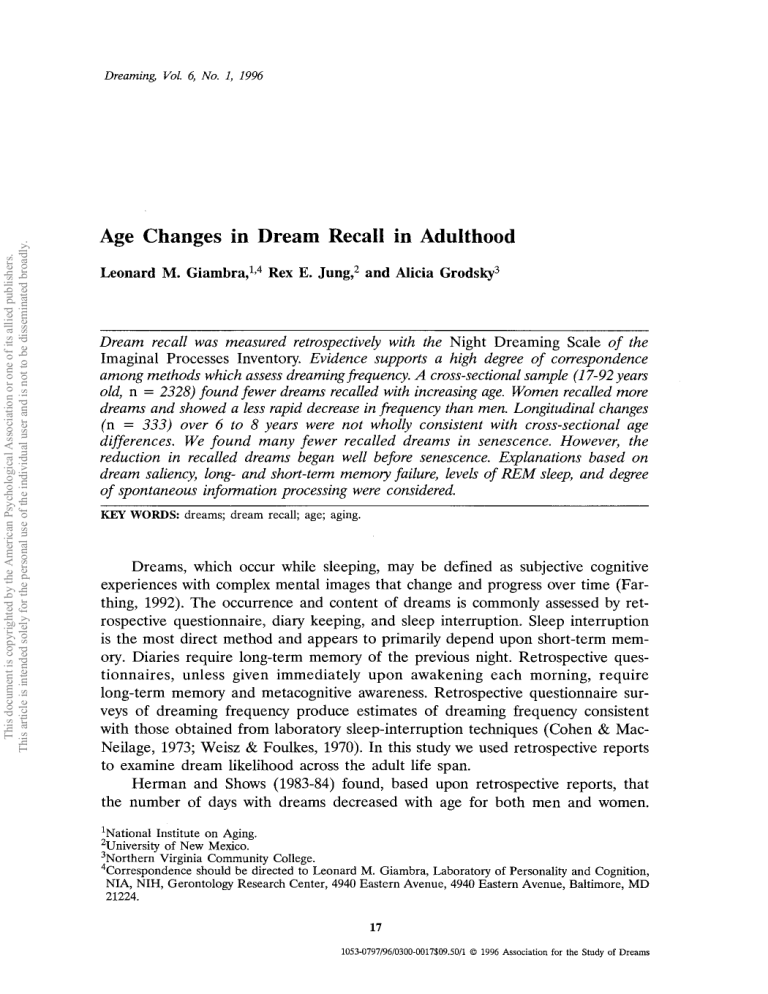
This document is copyrighted by the American Psychological Association or one of its allied publishers. This article is intended solely for the personal use of the individual user and is not to be disseminated broadly. Dreaming, Vol. 6, No.1, 1996 Age Changes in Dream Recall in Adulthood Leonard M. Giambra,1,4 Rex E. Jung,2 and Alicia Grodsky3 Dream recall was measured retrospectively with the Night Dreaming Scale of the Imaginal Processes Inventory. Evidence supports a high degree of correspondence among methods which assess dreaming frequency. A cross-sectional sample (17-92 years old, n = 2328) found fewer dreams recalled with increasing age. Women recalled more dreams and showed a less rapid decrease in frequency than men. Longitudinal changes (n = 333) over 6 to 8 years were not wholly consistent with cross-sectional age differences. We found many fewer recalled dreams in senescence. However, the reduction in recalled dreams began well before senescence. Explanations based on dream saliency, long- and short-term memory failure, levels of REM sleep, and degree of spontaneous information processing were considered. KEY WORDS: dreams; dream recall; age; aging. Dreams, which occur while sleeping, may be defined as subjective cognitive experiences with complex mental images that change and progress over time (Farthing, 1992). The occurrence and content of dreams is commonly assessed by retrospective questionnaire, diary keeping, and sleep interruption. Sleep interruption is the most direct method and appears to primarily depend upon short-term memory. Diaries require long-term memory of the previous night. Retrospective questionnaires, unless given immediately upon awakening each morning, require long-term memory and metacognitive awareness. Retrospective questionnaire surveys of dreaming frequency produce estimates of dreaming frequency consistent with those obtained from laboratory sleep-interruption techniques (Cohen & MacNeilage, 1973; Weisz & Foulkes, 1970). In this study we used retrospective reports to examine dream likelihood across the adult life span. Herman and Shows (1983-84) found, based upon retrospective reports, that the number of days with dreams decreased with age for both men and women. 1National Institute on Aging. 2University of New Mexico. 3Northern Virginia Community College. 4Correspondence should be directed to Leonard M. Giambra, Laboratory of Personality and Cognition, NIA, NIH, Gerontology Research Center, 4940 Eastern Avenue, 4940 Eastern Avenue, Baltimore, MD 21224. 17 1053-0797/96/0300-0017$09.50/1 © 1996 Association for the Study of Dreams This document is copyrighted by the American Psychological Association or one of its allied publishers. This article is intended solely for the personal use of the individual user and is not to be disseminated broadly. 18 Giambra, Jung, and Grodsky There was little difference between 40 and 69 years of age and women recalled more dreams than men after age 30 years. Waterman (1991) found that all young adults were able to recall five dreams, but only 73% of middle-aged and 65% of old adults could do so. Zepelin (1973), in a survey of 714 college alumni between 23 and 81 years old, reported an age-related decrease in dream recall, especially after 50 years of age. Giambra (1974, 1977-78, 1979-80), using a retrospective questionnaire, reported decreases in dream frequency which occurred in the thirties and, thereafter, either decreased or remained essentially at the same level for the subsequent years of life. Sleep parameters of the elderly differ somewhat from those of their younger counterparts. In general, the absolute time in REM sleep declines over the adult lifespan. Specifically, the average REM period remains relatively stable at 25-33 minutes through age 29 years for men and through age 49 years for women; thereafter, it declines to 22-24 minutes. Overall, REM periods occupy about 20% of the sleep cycle of middle-age adults and 16% of the sleep cycle of the elderly (Miles & Dement, 1980). Woodruff (1985), in her review, reports that REM periods in the elderly are more frequently interrupted by brief awakenings. Although dreams occur in non-REM sleep, it is reasonable to infer that the small reduction of REM sleep with increased age can only be partly responsible for fewer dreams and hence, fewer recalled dreams. Reduced dream recall with the elderly would also be expected as a result of memory decrements associated with senescence. We know that, over days to weeks, elderly adults have reduced long- and short-term memory, and are also susceptible to failures of initial memory consolidation (see, Giambra & Arenberg, 1993; Kausler, 1991 for a review). Theories of dream recall (see Farthing, 1992, for a review) point to several other aspects of dream recall in which the elderly may perform less efficiently relative to the young. The sleep state and the normal waking state are very different physiologically and in terms of contextual cues. If dreams enter long-term memory during sleep, then recall would be hindered because of the different cues available during wakefulness. Older adults seem to be more susceptible to memory failure when retrieval cues (i.e., "environmental support") are different from the original contextual cues (Craik, 1986; Craik & Jennings, 1992; Kausler, 1991), i.e., age differences in long-term memory are reduced or eliminated when retrieval is supported by the contextual cues which accompanied the original event. If dreams do enter long-term memory after awakening rather than during sleep, then events occurring at or proximal to awakening can interfere with consolidation of the dream memories. For the elderly, fewer dreams might be reported because fewer dreams entered their long-term memory. However, since old adults have more spontaneous awakenings during REM sleep than young adults (Woodruff, 1985) then if dreams enter long-term memory at awakening then they have more opportunities for dreams to enter long-term memory. Old adults also seem to be more susceptible to the detrimental effects of interference on memory (Kausler, 1991). Thus, the retrospective reports method, when applied to the elderly, would seem to be especially vulnerable to the loss of contextual cues and to the influence of interference-on both the recall and consolidation of memories. Fein, Feinberg, Insel, et al. (1985) found, upon awakening from REM sleep, that 69-74 year-olds recalled dreams 71.4% of the time while young subjects recalled 19 This document is copyrighted by the American Psychological Association or one of its allied publishers. This article is intended solely for the personal use of the individual user and is not to be disseminated broadly. Age Changes in Dream Recall dreams 90.2% of the time; for Stage 2 sleep recalled dreams were 47.2% and 60.3%, respectively, for the older and younger groups. If the percentage of REM sleep awakenings having dreams was reduced in the aged then a decrease in recalled dreams cannot be only a simple function of fewer REM periods. The age decrease could be due to fewer dreams or to recall failures or to reduced dream saliency in the elderly (Cohen, 1979). However, if age decreases in recalled dreams begin relatively early in adulthood, for example in the thirties and forties, it is unlikely that age-related decreases are solely or primarily the result of a decreased memory capacity. It is more likely to be primarily the result of an actual decrease in dream frequency. In this paper, we extend the earlier work of Giambra (1974, 1977-78, 1979-80) by examining intraindividual changes in dream frequency over a 6 to 8 year interval; in addition, we examine cross-sectional age differences with an increased sample size at all ages. If the decrease in dream frequency occurs before senescence then we would have further evidence that the decrease is true and not the result of increased memory failures. METHOD Subjects The cross-sectional sample included 1065 men and 1263 women 17 to 92 years old who answered the Night Dreaming Scale for the first time in the 1972-1976 or 1979-1984 periods. Most of the over-29 year-olds in the cross-sectional sample were participants in the Baltimore Longitudinal Study of Aging (BLSA; Shock, Greulich, et aI., 1984) at the Gerontology Research Center of the National Institute on Aging. Participants in the BLSA are unpaid volunteers who request participation on their own initiative. Virtually all are related to, or friends and acquaintances of, past and continuing participants in the BLSA. A relatively small number were informed about the BLSA by the media. The remaining non-BLSA subjects were usually recruited by church organizations and the church organizations paid for their participation. The 17-23 year-oIds were students recruited from Miami University of Ohio, Towson State University of Maryland, Community College of Baltimore, and Notre Dame College of Maryland. Most students participated to satisfy course requirements for experimental participation. The remainder were paid volunteers. The 24-29 year-old members of the sample were a mixture of students and BLSA participants. The sample was 89% Caucasian, 60% Protestant, 25% Catholic, 49% lived in a big city metropolitan area, 12% lived in a rural area or on a farm, and 92% rated themselves as being middle to upper-middle class. For men, 9% had one to three years of college education and 80% had four or more years of college education. For women, 21% had one to three years of college education and 56% had four or more years of college education. Medication information was not available for the full sample. The influence of medications on dream frequency cannot be determined in this sample. However, if dream frequency decreases in early adulthood then it is unlikely that the decrease was the result of medications. This document is copyrighted by the American Psychological Association or one of its allied publishers. This article is intended solely for the personal use of the individual user and is not to be disseminated broadly. 20 Giambra, Jung, and Grodsky The longitudinal sample consisted of 217 men aged 24 to 77 years old at first testing and 116 women aged 24 to 71 years old at first testing-there were too few women over age 71 years to be included in this analysis. The Night Dreaming Scale was first taken between 1972-1976 and was taken for the second time six to eight years later. Participants received identical instructions with each successive administration. Virtually all of the men were participants in the BLSA. Some of the women were also participants in the BLSA, but the majority were not. Most of the women were from communities in the Baltimore!Washington D.C. corridor, were recruited by BLSA members, and were related to, or friends and acquaintances of, BLSA members. These subjects are a subs ample of the cross-sectional sample. However, the longitudinal sample had a higher percentage of Caucasians, Protestants, and farm/rural residents than the cross-sectional sample. Night Dreaming Frequency Scale This scale is one of 28 scales of the Imaginal Processes Inventory (IPI; Singer & Antrobus, 1970; Giambra, 1980). The items are concerned with aspects of dreaming associated with frequency, detail and vividness of recall, and awareness of dreaming. All 12 items of this scale have five alternatives. The Appendix gives the items and their five alternative answers for the Night Dreaming Frequency Scale. The alternatives a, b, c, d, and e were assigned values of 0, 1, 2, 3, and 4, respectively. Scale values were computed by summing across the responses to all 12 items-minimum of zero, maximum of 48. Cronbach's alpha for this scale is .95 for both women and men (Giambra, 1979-80). For a one-year interval this scale has a test-retest correlation of 0.78 (Giambra, 1977-78). Procedure For BLSA participants, the IPI was usually taken alone or in small groups of two to six. One author (LMG) usually was present to answer questions and provide clarification. For many non-BLSA participants, the procedure was essentially the same. However, some men and a majority of women completed the IPI at home with all material received by mail. These individuals were instructed to contact LMG if any questions arose. The 17-23 year-old college students generally completed the IPI in a classroom setting in groups of 10 to 60 people. Results Cross-Sectional Analyses Each gender was partitioned into a 17-23 year-old group and 10 six-year age groups in the age range from 24 to 83 years-there were too few subjects to complete an over 83 year-old group. For women, the age group sample sizes were 535, 88, 125, 101, 78, 68, 85, 76, 58, 31, and 9, respectively, from youngest to oldest. 21 This document is copyrighted by the American Psychological Association or one of its allied publishers. This article is intended solely for the personal use of the individual user and is not to be disseminated broadly. Age Changes in Dream Recall For men, the age group sample sizes were 354, 54, 82, 68, 61, 82, 86, 102, 60, 65, and 34, respectively, from youngest to oldest. A Test Year (1972-1976, 1979-1984) x Age Group x Gender analysis of variance (ANOVA) determined that Test Year was not significant as a main effect, F < 1, nor in interaction with Age Group, F(9,2219) = 1.20, and Gender, F(1,2219) = 1.16, and with Age Group and Gender together, F(9,2219) = 1.07, allp > .05-the 78-83 year-old group was omitted from this analysis since cell sizes were too small when partitioned into Test Year subgroups. Because Test Year had no effect it was omitted from subsequent ANOVA and all age groups were used. An Age Group x Gender ANOVA found significant effects for Age Group, F(1O,2280) = 32.70, Gender, F(1,2280) = 19.73, and their interaction, F(10,2280) = 3.43, allp < .001. Separate one-way Age Group ANOVAs for each gender yielded a significant effect with men, F(10,1037) = 19.03, and with women, F(10,1243) = 16.22, both p < .001. Figure 1 provides a graphic depiction of the gender and age effects and their interaction. From Fig. 1, we see that women had greater mean values than men except with 17-23 and 54-83 year-olds where mean values were essentially the same. Figure 1 indicated a possible nonlinear trend with age. Therefore, a stepwise multiple regression, with quadratic and cubic age terms entered after a linear age term, was carried out. For men, both the quadratic and the cubic age terms each added a significant amount of variance, 3.1% and 0.9%, respectively, both F > 11.6, P < .001. The total variance accounted for by all age terms was 15.0%. For women, the quadratic and cubic terms together added 0.9% of variance, F(2,1259) = 5.87, P < .01. The total variance accounted for by all age terms was 11.0%. Figure 1 shows, for men and women separately, the nonlinear regression fit as well as the means for each age group. For men, mean scale 28 24 WOMEN 0 ~---""'" ~ « 20 0 ....J « () en ..'. ·b •• '. > w 0 '. '. 16 12 • Actual Values - - Regression Line 0 ........... W ....J MEN 0 ...... - ....... - ........ . '6'" • '. • ~ ............• ,"0 0 • 8 0=1" 14 20 26 32 38 44 50 56 62 68 74 80 86 GROUP MEAN AGE Fig. 1. Cross-sectional age group means and best fit age regression line for the Night Dream· ing Scale. This document is copyrighted by the American Psychological Association or one of its allied publishers. This article is intended solely for the personal use of the individual user and is not to be disseminated broadly. 22 Giambra, Jung, and Grodsky values decreased to age 36-41 years; thereafter, mean values remained essentially unchanged. For women, mean scale values showed a gradual decrease to the early fifties; thereafter, mean values remained essentially unchanged. The Appendix gives the percentage of each age group which endorsed each itemalternative of the 12 items of the Night Dreaming Scale. For example, from the Appendix we see that the percentage of men who report that "I have a night dream: several times a week or once a night or more" decreased unevenly from 61.1% in 17-23 year-olds to 22.5% in 78-83 year olds. The Appendix shows how the distribution of responses shifted with age from alternatives indicating more frequent or more intensive dreaming to alternatives indicating less frequent or less intensive dreaming. Longitudinal Analyses Age groups spanning six years were constituted. Six-year intervals were used so that the second point of a preceding group would have essentially the same age as the first point of the succeeding age group. All age groups had sample sizes of nine or greater. This resulted in 8 groups for the women-24-29 (n = 13), 30-35 (n = 19), 36-41 (n = 14), 42-47 (n = 9), 48-53 (n = 16), 54-59 (n = 17), 60-65 (n = 17), 66-71 (n = l1)-and 9 groups for men-24-29 (n = 11), 30-35 (n = 21), 36-41 (n = 20), 42-47 (n = 19), 48-53 (n = 24), 54-59 (n = 30), 60-65 (n = 42), 66-71 (n = 21), 72-77 (n = 15). An 8 (Age Group) x 2 (Gender) x 2 (Time of Testing) mixed model ANOVA determined that longitudinal change was influenced by gender. Therefore, an Age Group (8 levels for women, 9 levels for men) x Time of Testing mixed model ANOVA was separately carried out for men and women. For men, neither the longitudinal change, F < 1, nor its interaction with age group was significant, F(8,193) = 1.37, p > .05. Figure 2 shows neither general nor age-linked changes in mean Night Dreaming Scale values. For women, the longitudinal change was significant, F(I,108) = 4.27, p < .05, but not its interaction with age group, F(7,108) = 1.60, p > .05. Figure 2 shows 6-8 year longitudinal decreases in mean Night Dreaming Scale values in the two youngest age-at-first-testing groups (24-29, 30-35 years old) and in the three oldest groups (54-59, 60-65, 66-71 years old). In the 48-53 year olds the six year longitudinal change was an increase. The correlation of longitudinal change with age-at-firsttesting was less than 1.081, p > .05 for both men and women. The correlation between first and second testing was .69 for men and .75 for women, p < .001. DISCUSSION Clearly recalled dreams decreased in frequency from 17 to 35 years of age. Individuals older than 54 years of age recalled fewer night dreams than did individuals younger than 36 years of age. We obtained decreases in mean dream scale values at 29 years for men and at 49 years for women; ages where reductions in mean REM sleep interval time occur (Miles & Dement, 1980). Memory decrements cannot account for these decreases in frequency of recalled dreams since generalized memory decrements do not occur at these relatively young ages. Furthermore, 23 Age Changes in Dream RecaU 28 WOMEN MEN 6------6. A----A Longitudinal Group 24 w :::> --l This document is copyrighted by the American Psychological Association or one of its allied publishers. This article is intended solely for the personal use of the individual user and is not to be disseminated broadly. « > w --l « () 20 16 CJ) 12 8 O~L~L-~~--~~--~-L--L--L~L-~~ 14 20 26 32 38 44 50 56 62 68 74 80 86 GROUP MEAN AGE Fig. 2. Longitudinal age changes in mean values for the Night Dreaming Scale. Fein et al.'s (1985) results support the conclusion that, in the elderly, fewer dreams are occurring in REM sleep itself; a conclusion which is consistent with the view that less spontaneous information processing occurs with increased age, especially in the elderly (see Giambra, 1989). Cohen (1979) has indicated that reduced saliency of dreams in the elderly may account for reduced recall of dreams in the elderly. The two items which deal with vividness of dreams, see Appendix, indicate that vivid dreams occur infrequently in men after age 23 years and, in women, gradually decrease with increased age until age 54 years; after which there is little change. These items provide some support for Cohen's hypothesis that age-associated changes in dream recall may be the result of age-associated changes in dream saliency. Men showed neither general nor age contingent intraindividual change over 6 to 8 years. Intraindividual stability in recall was consistent with cross-sectional stability in men 36 years of age and older. The lack of a significant longitudinal change may have been the result of not having a 17-23 year-old group; the largest proportion of the cross-sectional drop in dream scale mean values occurred between the 17-23 and 24-29 year-old groups. Women showed intraindividual decreases in frequency of dream recall over 6 to 8 years that were especially evident in those initially under 36 years of age and over 54 years of age. Intraindividual decreases in dream recall were consistent with cross-sectional differences in the younger women. Intraindividual stability in recall was consistent with cross-sectional stability in 36 to 47 year-old women. For women, the intraindividual decreases in dream recall late in middle-age and early in old age were in contrast to the stability of cross-sectional means. The sample sizes for the longitudinal groups were much smaller than the cross-sectional groups. The inconsistencies between the longitudinal changes and the cross-sectional differences may simply be the result of these sample differences. 6.63 7.73 24.59 39.78 21.27 7.35 6.80 20.40 41.36 24.08 18.94 12.26 32.03 31.75 5.01 I have a night dream: rarely or never once a month several times a month several times a week once a night or more rarely or never once a month several times a month several times a week once a night or more I can recall a night dream: rarely or never once a month several times a month several times a week once a night or more 17-23 36.36 14.55 27.27 16.36 5.45 6.59 6.59 23.08 43.96 19.78 10.91 10.91 40.00 21.82 16.36 24-29 31.03 25.29 29.89 11.49 2.30 10.08 12.40 20.16 38.76 18.60 13.79 17.24 39.08 24.14 5.75 30-35 41.43 24.29 25.71 7.14 1.43 MEN 13.33 12.38 26.67 30.48 17.14 WOMEN 18.84 23.19 30.43 21.74 5.80 MEN 36-41 50.00 14.06 21.88 12.50 1.56 15.85 18.29 29.27 20.73 15.85 32.81 14.06 29.69 20.31 3.13 42-47 48.35 19.78 18.68 10.99 2.20 14.29 8.57 32.86 24.29 20.00 29.67 18.68 26.37 17.58 7.69 48-53 Age (Years) 51.06 26.60 14.89 6.38 1.06 29.67 14.29 25.27 18.68 12.09 24.73 20.43 27.96 20.43 6.45 54-59 47.17 22.64 16.98 11.32 1.89 23.08 19.23 20.51 23.08 14.10 26.42 21.70 15.09 23.58 13.21 60-65 37.10 20.97 27.42 12.90 1.61 19.05 15.87 30.16 23.81 11.11 16.13 9.68 35.48 27.42 11.29 66-71 53.62 15.94 15.94 7.25 7.25 27.27 9.09 33.33 21.21 9.09 27.54 14.49 23.19 27.54 7.25 72-77 The Items of the Night Dreaming Scale and the Percentage of Each Age Group Who Endorsed Each Item-Alternative APPENDIX This document is copyrighted by the American Psychological Association or one of its allied publishers. This article is intended solely for the personal use of the individual user and is not to be disseminated broadly. 55.00 15.00 20.00 7.50 2.50 40.00 7.50 30.00 17.50 5.00 78-83 ~ "" a '""" ~ =:I !>:> \!"l 1:1 ..... III ~ !>:> r:7' ~ .51 N "" I recall my night dreams vividly, i.e., extremely clearly: rarely or never once a month several times a month several times a week once a night or more 26.18 20.89 32.59 16.99 3.34 8.84 13.63 46.41 18.23 12.89 8.56 17.96 44.20 20.72 8.56 When I am sleeping, I seem to be dreaming: practically never just a little some of the time more of the time most of the time practically never just a little some of the time more of the time most of the time 19.52 10.87 28.55 36.10 4.97 rarely or never once a month several times a month several times a week once a night or more 17-23 52.73 18.18 21.82 3.64 3.64 8.79 13.19 49.45 20.88 7.69 12.73 38.18 34.55 10.91 3.64 19.57 6.52 31.52 40.22 2.17 ~4-29 39.08 31.03 22.99 4.60 2.30 14.73 16.28 45.74 13.95 9.30 20.69 28.74 40.23 5.75 4.60 19.38 16.28 28.68 30.23 5.43 30-35 52.86 25.71 15.71 5.71 0.00 MEN 17.76 19.63 46.73 6.54 9.35 WOMEN 31.88 28.99 34.78 1.45 2.90 MEN 24.76 18.10 27.62 23.81 5.71 WOMEN 36-41 58.46 15.38 18.46 6.15 1.54 24.10 19.28 46.99 7.23 2.41 29.69 25.00 35.94 7.81 1.56 24.10 22.89 34.94 15.66 2.41 42-47 APPENDIX. Continued 54.44 23.33 13.33 6.67 2.22 17.14 15.71 58.57 2.86 5.71 32.97 24.18 37.36 3.30 2.20 37.14 20.00 17.14 18.57 7.14 48-53 Age (Years) 67.02 19.15 7.45 4.26 2.13 20.88 32.97 34.07 6.59 5.49 29.03 29.03 37.63 4.30 0.00 47.78 22.22 18.89 7.78 3.33 54-59 59.43 14.15 16.04 8.49 1.89 21.79 28.21 38.46 8.97 2.56 26.17 28.97 38.32 5.61 0.93 52.56 16.67 16.67 11.54 2.56 60-65 51.61 16.13 20.97 8.06 3.23 30.16 19.05 41.27 4.76 4.76 21.31 31.15 39.34 4.92 3.28 37.70 26.23 18.03 11.48 6.56 66-71 This document is copyrighted by the American Psychological Association or one of its allied publishers. This article is intended solely for the personal use of the individual user and is not to be disseminated broadly. 56.52 20.29 10.14 7.25 5.80 30.30 30.30 30.30 6.06 3.03 30.43 26.09 34.78 7.25 1.45 60.61 21.21 9.09 9.09 0.00 72-77 62.50 20.00 12.50 5.00 0.00 37.50 17.50 35.00 10.00 0.00 78-83 N (IJ ~ 5! ~ 10 ~ t::I '"5' ; 10 =- (") ~ to 7.75 25.09 18.27 37.82 11.07 vague impressions fragments general plot main plot with great detail clearly with great detail 11.33 9.12 25.69 34.25 19.61 11.33 21.55 24.31 31.22 11.60 I recall my night dreams in the form of: vague impressions fragments general plot main plot with great detail clearly with great detail A night's sleep for me contains a dream: rarely or never once a month several times a month several times a week once a night or more 28.49 15.44 30.88 21.51 3.68 rarely or never once a month several times a month several times a week once a night or more 17-23 16.36 21.82 29.09 21.82 10.91 7.78 17.78 18.89 41.11 14.44 7.41 38.89 12.96 31.48 9.26 19.57 17.39 39.13 20.65 3.26 24-29 19.54 19.54 35.63 20.69 4.60 7.81 18.75 19.53 40.63 13.28 11.76 31.76 20.00 30.59 5.88 25.58 24.81 23.26 23.26 3.10 30-35 30.43 24.64 28.99 11.59 4.35 MEN 11.43 31.43 17.14 26.67 13.33 WOMEN 12.86 38.57 21.43 22.86 4.29 MEN 31.13 29.25 22.64 14.15 2.83 WOMEN 36-41 36.92 20.00 20.00 20.00 3.08 12.35 23.46 18.52 32.10 13.58 25.40 31.75 19.05 19.05 4.76 34.94 26.51 25.30 12.05 1.20 42-47 APPENDIX. Continued 38.46 16.48 25.27 14.29 5.49 14.49 27.54 18.84 31.88 7.25 22.89 25.30 13.25 28.92 9.64 37.14 27.14 17.14 14.29 4.29 48-53 Age (Years) 35.11 18.09 27.66 12.77 6.38 23.33 20.00 16.67 31.11 8.89 28.41 31.82 17.05 19.32 3.41 55.56 22.22 13.33 6.67 2.22 54-59 34.29 19.05 19.05 15.24 12.38 20.51 37.18 12.82 14.10 15.38 22.33 33.01 20.39 20.39 3.88 62.82 12.82 14.10 8.97 1.28 60-65 27.42 14.52 30.65 17.74 9.68 32.81 29.69 10.94 15.63 10.94 26.23 29.51 16.39 24.59 3.28 54.10 21.31 16.39 4.92 3.28 66-71 This document is copyrighted by the American Psychological Association or one of its allied publishers. This article is intended solely for the personal use of the individual user and is not to be disseminated broadly. 36.23 21.74 23.19 13.04 5.80 33.33 33.33 15.15 12.12 6.06 34.85 22.73 24.24 12.12 6.06 63.64 15.15 12.12 9.09 0.00 72-77 38.46 15.38 28.21 15.38 2.56 36.11 13.89 22.22 25.00 2.78 78-83 ""'" ~ <:> .,G"l Q.. '" ill t:: !!" '= "" J> 9 .,.. ... ill g 0\ N 10.66 8.27 23.16 36.76 21.14 22.07 20.11 32.68 21.79 3.35 21.92 14.18 32.78 27.07 4.05 22.99 39.89 15.79 18.84 2.49 rarely or never once a month several times a month several times a week once a night or more I recall my night dreams fairly clearly: rarely or never once a month several times a month several times a week once a night or more rarely or never once a month several times a month several times a week once a night or more I have a really vivid night dream: rarely or never once a month once a week several times a week once a night or more 17-23 45.45 34.55 12.73 5.45 1.82 11.96 15.22 36.96 31.52 4.35 38.18 21.82 27.27 7.27 5.45 9.89 4.40 24.18 45.05 16.48 24-29 47.13 35.63 13.79 2.30 1.15 18.60 24.81 26.36 26.36 3.88 34.48 28.74 25.29 9.20 2.30 14.17 8.66 22.05 39.37 15.75 30-35 51.43 32.86 12.86 1.43 1.43 MEN 28.97 27.10 23.36 17.76 2.80 WOMEN 47.14 28.57 20.00 4.29 0.00 MEN 19.81 13.21 29.25 23.58 14.15 WOMEN 36-41 50.77 27.69 12.31 9.23 0.00 31.33 20.48 31.33 15.66 1.20 61.90 11.11 20.63 6.35 0.00 24.10 15.66 30.12 16.87 13.25 42-47 APPENDIX. Continued 56.04 28.57 8.79 5.49 1.10 34.29 20.00 22.86 17.14 5.71 50.00 23.86 14.77 10.23 1.14 21.43 12.86 25.71 21.43 18.57 48-53 Age (Years) 58.06 32.26 5.38 3.23 1.08 49.44 20.22 21.35 6.74 2.25 57.61 22.83 11.96 5.43 2.17 35.56 17.78 20.00 14.44 12.22 54-59 50.00 31.13 10.38 8.49 0.00 60.26 14.10 12.82 10.26 2.56 51.43 19.05 18.10 8.57 2.86 35.06 18.18 19.48 19.48 7.79 60-65 51.61 19.35 24.19 4.84 0.00 46.77 17.74 19.35 14.52 1.61 43.55 24.19 19.35 11.29 1.61 30.16 14.29 28.57 17.46 9.52 66-71 This document is copyrighted by the American Psychological Association or one of its allied publishers. This article is intended solely for the personal use of the individual user and is not to be disseminated broadly. 57.35 27.94 8.82 4.41 1.47 66.67 12.12 9.09 12.12 0.00 58.82 17.65 13.24 4.41 5.88 34.28 25.00 18.75 12.50 9.38 72-77 61.54 20.51 15.38 2.56 0.00 57.89 15.79 15.79 10.53 0.00 78-83 fl) N -..I ~ ..,~ a III ." I::l . '"'" ;. (J<l 1:3 ~ ("J ::s' ~ 28.41 35.24 16.42 18.45 1.48 14.44 15.83 35.28 30.83 3.61 16.42 13.47 28.78 35.42 5.90 19.94 29.64 31.30 17.17 1.94 rarely never once a month once a week several times a week once a night or more I recall my night dreams in some form: rarely or never once a month several times a month several times a week once a night or more rarely or never once a month several times a month several times a week once a night or more I recall interesting or elaborate night dreams: rarely or never once a month several times a month several times a week once a night or more 17-23 41.82 23.64 21.82 9.09 3.64 14.29 8.79 34.07 40.66 2.20 25.45 16.36 38.18 16.36 3.64 20.65 44.57 23.91 7.61 3.26 24-29 39.53 31.40 23.26 4.65 1.16 16.41 19.53 28.13 31.25 4.69 26.74 20.93 34.88 15.12 2.33 25.58 41.09 14.73 14.73 3.88 30-35 51.43 25.71 14.29 8.57 0.00 MEN 20.56 27.10 27.10 21.50 3.74 WOMEN 42.86 27.14 21.43 8.57 0.00 MEN 41.12 36.45 14.02 7.48 0.93 WOMEN 36-41 56.92 18.46 18.46 6.15 0.00 25.93 20.99 34.57 13.58 4.94 46.15 18.46 23.08 12.31 0.00 37.80 45.12 7.32 7.32 2.44 42-47 APPENDIX. Continued 53.93 25.84 14.61 5.62 0.00 32.86 18.57 24.29 18.57 5.71 47.19 19.10 22.47 10.11 1.12 43.48 36.23 7.25 8.70 4.35 48-53 Age (Years) 64.52 21.51 9.68 2.15 2.15 43.82 22.47 21.35 10.11 2.25 48.91 25.00 18.48 3.26 4.35 60.00 27.78 7.78 4.44 0.00 54-59 50.94 29.25 13.21 6.60 0.00 61.54 12.82 15.38 10.26 0.00 46.23 17.92 23.58 11.32 0.94 62.34 19.48 10.39 7.79 0.00 60-65 45.16 25.81 22.58 6.45 0.00 45.16 24.19 17.74 11.29 1.61 40.32 19.35 24.19 12.90 3.23 41.94 38.71 6.45 11.29 1.61 66-71 This document is copyrighted by the American Psychological Association or one of its allied publishers. This article is intended solely for the personal use of the individual user and is not to be disseminated broadly. 64.71 17.65 11.76 2.94 2.94 62.50 18.75 9.38 9.38 0.00 57.97 20.29 13.04 4.35 4.35 66.67 15.15 12.12 6.06 0.00 72-77 64.10 15.38 15.38 5.13 0.00 57.50 17.50 20.00 5.00 0.00 78-83 . ~ '" Cl. C':I .'" Cl. I>l ~ := = = .... J' C':I £i' rs r:r IN 00 I am awakened with the realization that I have been dreaming: rarely or never once a month several times a month several times a week once a night or more 16.76 14.53 33.24 26.26 9.22 0.37 10.11 36.03 40.81 12.68 1.66 10.53 38.50 37.67 11.63 I consider myself a person who night dreams: never rarely occasionally frequently a great deal never rarely occasionally frequently a great deal 22.10 24.13 34.25 16.76 2.76 rarely or never once a month several times a month several times a week once a night or more 17-23 38.18 18.18 23.64 14.55 5.45 0.00 10.87 29.35 47.83 11.96 1.82 23.64 41.82 18.18 14.55 18.68 23.08 41.76 15.38 1.10 24-29 41.86 22.09 25.58 8.14 2.33 0.78 16.28 31.78 41.86 9.30 1.16 24.42 54.65 18.60 1.16 24.03 23.26 29.46 19.38 3.88 30-35 52.86 24.29 17.14 2.86 2.86 MEN 2.80 21.50 39.25 27.10 9.35 WOMEN 4.29 34.29 45.71 12.86 2.86 MEN 38.32 32.71 19.63 6.54 2.80 WOMEN 36-41 40.00 23.08 29.23 7.69 0.00 2.41 27.71 42.17 16.87 10.84 7.81 34.38 39.06 17.19 1.56 37.04 30.86 22.22 8.64 1.23 42-47 APPENDIX, Continued 52.81 14.61 23.60 6.74 2.25 1.43 21.43 38.57 27.14 11.43 6.59 36.26 43.96 12.09 1.10 42.03 21.74 23.19 10.14 2.90 48-53 Age (Years) 45.74 27.66 15.96 7.45 3.19 2.22 35.56 32.22 24.44 5.56 8.51 37.23 36.17 14.89 3.19 52.33 20.93 17.44 8.14 1.16 54-59 45.28 25.47 15.09 12.26 1.89 2.56 38.46 29.49 23.08 6.41 5.66 40.57 30.19 18.87 4.72 69.23 12.82 10.26 7.69 0.00 60-65 37.10 19.35 24.19 14.52 4.84 0.00 39.06 34.38 17.19 9.38 4.84 30.65 38.71 20.97 4.84 55.74 21.31 14.75 6.56 1.64 66-71 This document is copyrighted by the American Psychological Association or one of its allied publishers. This article is intended solely for the personal use of the individual user and is not to be disseminated broadly. 45.59 23.53 14.71 14.71 1.47 6.25 37.50 31.25 15.63 9.38 5.88 41.18 33.82 14.71 4.41 0.00 6.25 65.63 18.75 9.38 72-77 43.59 28.21 20.51 7.69 0.00 12.82 41.03 25.64 17.95 2.56 78-83 N \J:> ~ I» ...~ '"e ..,~ '" 5' til I7<l 1» "'=" ~ ~ til 17.34 15.87 30.81 30.63 5.35 19.57 8.70 28.26 36.96 6.52 24-29 22.48 17.83 29.46 24.03 6.20 30-35 Note. Age groups omitted if n < 20, see text for cell sizes. rarely or never once a month several times a month several times a week once a night or more 17-23 28.30 25.47 24.53 15.09 6.60 WOMEN 36-41 31.33 18.07 27.71 18.07 4.82 42-47 APPENDIX. Continued 34.29 18.57 22.86 17.14 7.14 Age (Years) 48-53 48.35 13.19 20.88 13.19 4.40 54-59 50.00 11.54 21.79 10.26 6.41 60-65 38.10 25.40 17.46 11.11 7.94 66-71 This document is copyrighted by the American Psychological Association or one of its allied publishers. This article is intended solely for the personal use of the individual user and is not to be disseminated broadly. 48.48 21.21 15.15 12.12 3.03 72-77 78-83 e i i ~ l il a- ~ Q ..,., 31 Age Changes in Dream Recall This document is copyrighted by the American Psychological Association or one of its allied publishers. This article is intended solely for the personal use of the individual user and is not to be disseminated broadly. REFERENCES Cohen, D. B. (1979). Remembering and forgetting dreaming. In J. F. Kihlstrom & F. J. Evans (Eds.), Functional disorders of memory. Hillsdale: Lawrence Erlbaum Associates. Cohen, D. B., & MacNeilage, P. F. (1973). A test of the salience hypothesis of dream recall. Journal of Consulting and Clinical Psychology, 42, 699-703. Craik, F. I. M. (1986). A functional account of age differences in memory. In F. Klix and H. Hagendorf (Eds.), Human memory and cognitive capabilities (pp. 409-422). Amsterdam: Elsevier Science. Craik, F. I. M., & Jenning, J. M. (1992). Human memory. In F. I. M. Craik & T. A. Salthouse (Eds.), The handbook of aging and cognition (pp. 51-110). Hillsdale, N. J.: Lawrence Erlbaum. Fein, G., Feinberg, I., Insel, T. R, Antrobus, J. S., Price, L. J., Floyd, T. c., & Nelson, M. A. (1985). Sleep mentation in the elderly. Psychophysiology, 22, 218-225. Farthing, G. W. (1992). The psychology of consciousness. Englewood Cliffs: Prentice-Hall. Giambra, L. M. (1974). Daydreaming across the life span: Late adolescence to senior citizen. International Journal of Aging and Human Development, 5, 115-140. Giambra, L. M. (1977-78). Adult male daydreaming across the life span: A replication, further analyses, and tentative norms based upon retrospective reports. International Journal of Aging and Human Development, 8, 197-228. Giambra, L. M. (1979-80). Sex differences in daydreaming and related mental activity from late teens to the early nineties. International Journal of Aging and Human Development, 10, 1-34. Giambra, L. M. (1980). A factor analysis of the items of the Imaginal Processes Inventory. Journal of Clinical Psychology, 36, 383-409. Giambra, L. M. (1989). Task-unrelated thought frequency as a function of age: A laboratory study. Psychology and Aging, 4, 136-143. Giambra, L. M., & Arenberg, D. (1993). Adult age differences in forgetting sentences. Psychology and Aging, 8, 451-462. Herman, S., & Shows, W. D. (1983-84). How often do adults recall their dreams? International Journal of Aging and Human Development, 18, 243-254. Kausler, D. (1991). Experimental psychology, cognition, and human aging, 2nd edition. New York: Springer-Verlag. Miles, L. E., & Dement, W. C. (1980). Sleep and aging. Sleep, 3, 119-220. Shock, N. W., Greulich, R C., Andres, R, Arenberg, D., Costa, P. T., Jr., Lakatta, E. G., & Tobin, J. D. (1984). Normal human aging: The Baltimore Longitudinal Study of Aging. (NIH Publication No. 84-2450). Bethesda, MD: The National Institutes of Health. Singer, J. L., & Antrobus, J. S. (1970). Manual for the Imaginal Processes Inventory. Princeton, New Jersey: Educational Testing Service. Waterman, D. (1991). Aging and memory for dreams. Perceptual and Motor Skills, 73, 355-365. Weisz, R, & Foulkes, D. (1970). Home and laboratory dreams collected under uniform sampling conditions. Psychophysiology, 6, 588-596. Woodruff, D. S. (1985). Arousal, sleep, and aging. In J. E. Birren & K. W. Schaie (Eds.), Handbook of the psychology of aging (pp. 261-295). New York: Van Nostrand Reinhold. Zepelin, H. (1973). A survey of age differences in sleep patterns and dream recall among well-educated men and women (Abstract). Sleep Reviews, 2, 81.
